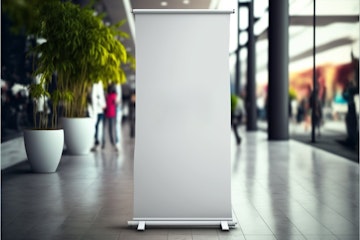Just like the best advertising campaigns never leave the television screens, the best trade show exhibitors are constantly planning for the next big event. The advice in this section will help ensure that your trade show exhibit isn’t just a success, but a success that can be measured, calculated for ROI, and repeated in the future.
The Importance of Preparing Responsibilities
When you’re managing a trade show exhibit and a business, it can tempting to jump back and forth between your responsibilities at the event and your responsibilities at the office.
Instead of trying to balance two full-time jobs, delegate your office responsibilities and focus entirely on the trade show. Single-tasking is the key to success at a trade show – not poorly managed multitasking.
If you’re exhibiting with several other staff members, spend some time going over each person’s responsibilities in the weeks before the show. Assign tasks based on your staff’s strengths – for example, give your sales staff the job of interacting with prospects as they enter your booth, and your customer service staff the job of giving out promotional material and giveaway items.
The best trade show exhibits are staffed by people with a diverse range of skills. For this reason, it’s worth bringing technical staff to trade shows, as they can answer a lot of product-related questions that sales staff may struggle with.
Whether you’re exhibiting at the event purely to generate sales leads or to establish your brand, making sure that your staff are fully invested in the event (and that their day-to-day job applications are covered by their colleagues) is vital for success.
Prepare According to the Trade Show’s Audience
Just as half of advertising success is finding the right audience to market to, half of trade show success is preparing the right approach for the right type of event.
There are two different types of trade show that your business may want to exhibit at: vertical trade shows and horizontal trade shows. While both types of event have advantages, they require a different approach to deliver a positive ROI.
Vertical trade shows bring together a wide range of attendees within a very specific industry. These trade shows are generally attended by businesses at every level of the supply chain, from manufacturers to wholesalers to distributors to retailers.
Example: The ad:tech events are vertical trade shows targeted at the advertising industry. They attract a very narrow demographic (advertising industry vendors and purchasers) but attract attendees from every level of the supply chain.
Horizontal trade shows bring together attendees from a wide range of different industries, often at just one point on the supply chain. An example of a horizontal trade show is a wholesale convention with thousands of diverse vendors.
Example: The Canton Fair is a horizontal trade show targeted at a wide variety of retailers that import products from China. The event attracts a wide demographic and the majority of exhibitors are vendors (manufacturers and wholesalers).
Keep the type of show that you’re attending in mind when you choose whether or not a particular trade show is worth attending. You can see if a certain trade show has opportunities for your business by looking at the list of exhibitors.
If a trade show has too broad an audience, you may not benefit from it as much as you would a more specialised event. Remember that trade shows are measurable marketing, and that money spent on a trade show that doesn’t suit your business could be better spent on a show that would deliver a higher ROI on future sales.
"...delegate your office responsibilities and focus entirely on the trade show"
Understand your Space and its Requirements
The best way to have a successful trade show experience is to learn every detail you can about your space. Work out where you’ll be located on the floor, where you’ll be relative to your competitors, and even which direction you’ll be facing.
The location of your exhibit can make or break your trade show experience, and it’s essential that you have the right strategy for the right location. Is your area a high or low foot traffic location? Is it lit by natural light or towards the back of the hall with harsh artificial lighting?
Every little detail makes a difference, and it needs to play into the strategy that you use to make your trade show exhibit a success. A space near the back of the exhibition hall isn’t always a bad thing – in fact, with the right strategy, it could help you attract dedicated attendees that are searching around for a deal.
Before you book floor space, try to learn which exhibitors you’ll be located beside. If your business offers a deal that beats one of your competitors, for example, you can easily ‘steal’ their leads by strategically placing a pop up banner or other display with a unique offer next to their stands to lure in customers interested in their product or service.
Beyond the strategic elements of your booth space, it’s important to know where you’re located relative to utilities and services. Map out the nearest power outlet and work out if you’ll need extension cords. Work out the location of the nearest toilet and memorise it to avoid walking aimlessly through other stands.
Think about factors that could lead to sales success – is there a café or restaurant near your stand that you could use to close deals with prospects away from the noisy exhibition hall? Looking for small things like this helps you find opportunities that can result in more leads, more sales, and more interest in your business.
Make a checklist of important items for your booth and have them ready before you attend the event. Simple things like rubbish bins, electrical cables, pens and pencils, and even phone chargers are easy to forget when you’re rushing to the event.

Measure Success using Quantifiable Objectives
Attending a trade show with the end goal of ‘getting more leads’ is an expensive and time-consuming recipe for failure. Like any other form of outbound marketing, trade shows need to be tracked and measured using quantifiable goals and metrics.
‘Improving branding with our audience’ is a goal that can’t be measured objectively. It’s a legitimate goal for marketers, particularly those attending a trade show, but it isn’t the type of goal that you can clearly assess as being achieved or failed.
Thankfully, it’s easy to make this goal measurable by breaking it down into several smaller, quantifiable objectives. Since brand value can be measured by the amount of people searching for your business’s name, you could change the goal to a certain amount of Google search impressions for your company website.
This effectively targets the same goal (an increase in brand recognition) without the subjectivity of the original objective. Your goals need to be objective and measurable to be something that you can track, measure, and improve over time.
Another subjective goal is ‘connect with more prospects.’ While it’s a great goal, and one that all sales departments share, it’s not the type of goal that is measured. It’s a subjective goal, and while subjective goals aren’t necessarily bad, they shouldn’t be the type of goals that your marketing campaigns are judged upon.
Like the branding goal, the goal of connecting with more prospects is easy to change into a more measurable objective. In fact, it could be measured using one of several different quantifiable objectives:
Exchange business cards with 200 new prospects by the end of day one.
Get 50 phone numbers from Purchasing Managers by lunchtime.
Close sales on the spot with at least five attendees by the end of day two.
These are three basic examples that may or may not suit your business. However, the key point behind using quantifiable objectives is simple: you need to be able to measure your results, and abstract results simply can’t be measured accurately.
Abstract thinking is immensely important in marketing, but it shouldn’t play any role in the way you assess the success of your trade show exhibit.
Set Fun, Achievable Goals and Deadlines to Encourage your Team
When you’re setting goals for your trade show exhibit, a great way to achieve them without feeling pressured or stressed is to break them down into small, achievable goals that you can work towards as a team.
If you have 500 business cards to give out, set yourself a deadline for getting them all in prospects’ hands, and break the deadline down into several smaller goals to give yourself some breathing room. Start with 50 cards handed out before lunch, then try to reach 150 cards exchanged by the end of the first day.
You can do this with your team by creating a group objective that you work towards over the course of the trade show. To encourage hard work, you can even create a competition and reward the highest-selling or best brochure-giving member.
Some simple goals and deadlines that can be used to encourage your team include:
Collect 50 business cards each from prospects during the first day of the trade show. The first sales rep to reach their goal could earn a bonus, and the entire team could earn a special bonus if everyone meets their goal.
Close five sales, complete with signatures on purchase orders, during the first day of the show. A great way to encourage sales reps to close deals during the event is to offer a special commission on trade show sales.
Double your previous one-day sales record. This is a great objective if you’ve exhibited at trade shows before, since motivated sales reps love to beat their own records.
Talk to ten different prospects for at least two minutes each. This is a great goal to begin the show, since a two-minute conversation is an easy task to achieve, and a short conversation is very likely to turn into a long one.
The most important aspect of a successful mini-goal is simplicity. Your goals need to be simple, smart, and short. If you set an incredibly ambitious goal for your first day and fail to meet it, you’ll suffer from damaged morale and poor motivation.
Another reason it’s important to set small goals is that they’re easy to monitor and revise. Big goals are rigid and difficult to change, but small goals can be adapted to suit your new strategy if you ever need to resort to your backup plan.
If you’re struggling to think up goals for your sales team, use the SMART mnemonic:
Specific / Measurable / Attainable / Relevant / Time-bound
There’s nothing more demoralising than watching your only tactic fail. If you build your trade show objectives around a single tactic without any type of backup plan, you’re setting yourself up for an expensive and demoralising failure.
Successful trade show marketers don’t develop tactics – they develop strategies that can withstand failure after failure without crumbling. If you want to leave your trade show with hundreds of valuable leads, you need to have a strategy that can adapt to failure and immediately change to suit the situation that you’re facing.
One of the best ways to do this is to test different tactics on the first day of the event and gradually focus on the most successful one. Switch between a soft and hard sell with prospects and see if one has a higher average conversion rate.
You can also test different environments to see if they have an impact on your sales success. Try closing sales in your booth, and compare it to closing sales in a café or restaurant nearby. You might find that the quiet environment is an easier place to convince prospects to become customers.
Your Plan B shouldn’t only be for sales tactics. In fact, it should cover every aspect of running a successful trade show exhibit. This means being prepared if your display stand is lost in transit or your business cards aren’t printed in time. A flexible Plan B lets you turn a major crisis into a manageable and stress-free opportunity.

Research the show and sync your marketing with its message
Trade show marketing is all about narrative. If you’re exhibiting at a show where a new development is occurring, making your business part of the narrative gives you access to valuable media coverage. This narrative could stem from a product launch or keynote presentation given by one of the trade show’s guest speakers.
High-profile industry experts use trade shows to introduce new concepts. Leading companies use trade shows to announce new products. Both attract the media and become talking points for coverage of the trade show, giving you an opportunity to position your business as part of the narrative.
Research guest speakers and learn about the concepts that they like to use in their trade show presentations. You can then tailor your exhibition stands focus to convey your business’s role in the trend or strategy that they talk about.
Example: If your event attracts a guest speaker who is an advocate for green energy and clean technology, you can use their speech as an opportunity to emphasise your business’s green credentials. This puts your business in a position to access media coverage that wouldn’t be available with a less green-focused exhibit.
Synchronising your marketing efforts with a show’s message is all about showing off the qualities of your business that are most newsworthy. If your business genuinely offers something of value that fits in with the show’s focus, you can contact the trade show organisers and ask to be featured as an example in pitches to the media.
PR consultant Miranda Tan explains how to contact PR staff and media reporters in the months leading up to a trade show in this YouTube video. You may also want to launch a formal PR campaign using press releases and media interviews to better position yourself during the conference.
Rehearse, rehearse, and rehearse again
Would you stand in front of hundreds of prospective customers and give a speech that you had never practiced? Of course not. While you can change your strategy over the course of a trade show, it’s still important to practice your sales tactics prior to the show to iron out any issues that you may not have noticed.
The conversations that you’ll have at a trade show are dynamic, and having a sales script prepared might not be the best solution. However, it’s worth writing a rough conversation plan that you and your sales reps can use to close deals and avoid any awkward moments when interacting with prospects.
Have a ‘dress rehearsal’ in your office about a week before you travel to the trade show to familiarise yourself and your team with your strategy. Play the role of a valuable prospect that could become a top customer for your company, and ask tough questions to your sales reps to test their knowledge of your product.
Grilling your sales team with difficult questions about your product helps reduce nervousness and lets you solve problems with your sales strategy before it comes under fire from real customers.
posted in Trade Show Guide
Share this Event







